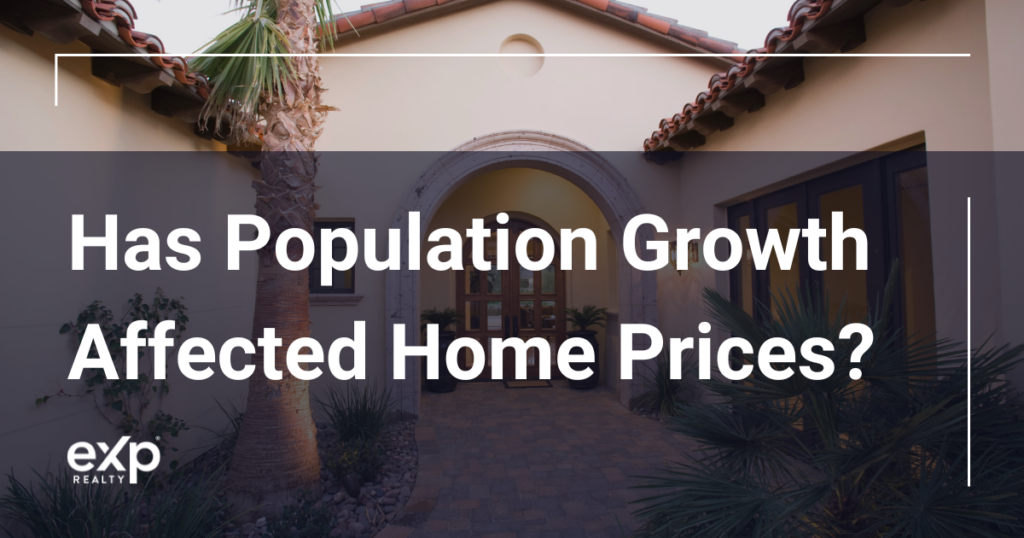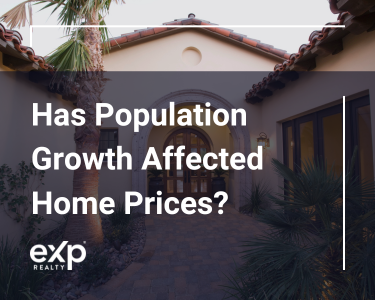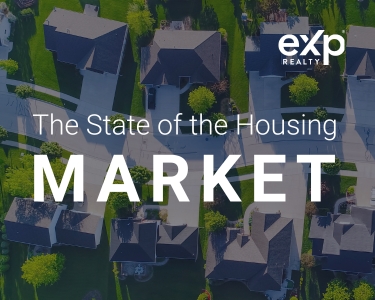This content is written and researched by eXp World Holdings subsidiary Zoocasa. This award-winning prop-tech company uses data and technology to deliver an intelligent, end-to-end real estate experience. View the original article here.
Despite borrowing costs being some of the highest in decades, home prices continue to rise across the US. According to the National Association of Realtors®, the national median price for existing single-family homes in April rose by 5.7% year-over-year to $407,600. The West and Northeast experienced the largest year-over-year price gains with their median prices rising by 9.3% and 8.5% respectively. Many experts cite the lack of housing supply as the culprit driving prices upward, but increasing demand is also a factor.

During and after the COVID-19 pandemic, population shifts occurred in many US cities as some homebuyers moved to the suburbs to escape city life while others returned to urban areas for in-person work. But what role has population growth had on home prices?
Using the latest data from the US Census Bureau, Zoocasa analyzed how population changes in cities or towns with more than 100,000 people impacted median single-family home prices from July 2022 to May 2024. We focused on places where the population changed by more than 0.5%, either increasing or decreasing between July 2022 and July 2023. By comparing median home prices from 2022 to 2024, we calculated the percentage difference in home prices in relation to these population shifts in 109 cities.
Majority of US Housing Markets Experienced Price Growth From 2022 to 2024
Out of 109 cities, the median single-family home price increased in 74 of them (67.9%) from July 2022 to May 2024. Among the cities that experienced population growth during this period, 50 cities also experienced home price growth. While factors such as inflation, construction costs, economic growth, and housing supply influence home prices, population growth can also be a significant driver, especially in cities with already low supply levels. As more people move into a city, demand for housing increases, leading to higher home prices.
However, cities with the greatest population change did not always have the greatest change in median single-family home prices. For instance, the population in Providence, RI increased by 0.6% from July 2022 to July 2023, while the median single-family home price increased by an impressive 40.8% - the highest percentage change of the cities we analyzed. Smaller and mid-sized cities like Providence may be more impacted by population increases than larger cities due to their constrained housing supply. According to the Rhode Island Association of Realtors, there were just 999 listings available in the state in April 2024, down from 1,115 in April 2022.
Tuscaloosa, AL, Charleston, SC, Irvine, CA, and Olathe, KS complete the top five cities experiencing the largest increases in median home prices from 2022 to 2024. Of the four, Olathe and Charleston’s populations grew the most, by 1.3% and 1.1% respectively. This resulted in Olathe’s median single-family home price rising by 14.9% to $454,261 and Charleston’s median single-family home price rising by 23.7% to $700,000.
Significant Home Price Gains in Smaller Cities
In 17 cities, the median single-family home price increased by more than 10% from July 2022 to May 2024. All but three of these had a positive population shift, with Suffolk, VA, and Chattanooga, TN experiencing the largest population gains at 2.3% and 1.6% respectively. In response, Suffolk’s median single-family home price rose by 11.3%, while Chattanooga’s rose by 12.4%.
Among the 17 cities with price changes of more than 10%, nearly all have populations of less than 300,000. Only Irvine, CA, Anaheim, CA, and New York, NY have populations exceeding 300,000, indicating how housing demand is growing in smaller secondary and tertiary cities.
Florida, Idaho, and Arizona Cities Lead in Population Increases
When looking at cities with populations over 100,000, the top ten cities experiencing the greatest population growth include three cities in Florida, three in Arizona, and two in Idaho. The only cities from other states in the top ten are Greeley, CO, and McKinney, TX.
Throughout the pandemic, Florida’s housing market was red hot, and this wasn’t limited to just the large metropolitan areas. Port St. Lucie and Palm Bay experienced the largest percentage increase in population, at 5.7% and 4.9% respectively, and as a result, their respective median single-family home prices rose by 4.9% and 3.3% from 2022 to 2024. Cape Coral is another Florida city that experienced a significant population increase of 3.5%, with home prices rising by 1.2%.
Even with population growth surpassing 0.5% in six Arizona cities, four of these cities experienced a drop in median single-family home prices between 2022 and 2024 including Goodyear and Glendale. Scottsdale was the only city in Arizona where the median home price increased over two years, rising significantly by 13.7% to $1,200,000 in May 2024.
Idaho cities faced a similar fate as those in Arizona. Despite population increases of 3.9% in Meridian and 3.1% in Nampa, median single-family home prices dropped from 2022 to 2024—by 6.5% in Meridian and 4.1% in Nampa. These price drops may have less to do with population density, and more to do with supply and demand balancing out. According to Boise Regional Realtors, housing inventory in Ada County (Meridian’s location) was up by 29.4% year-over-year in May 2024, while resale sales were up 10.5% year-over-year. This suggests that higher inventory and steady sales helped ease price pressures that could have resulted from population growth.
“Population growth alone does not guarantee home price increases, but in cities with a persistent lack of housing supply, it can significantly drive prices up,” says Carrie Lysenko, Zoocasa CEO. “Cities experiencing population growth are often those with strong economic indicators and significant job opportunities. This economic vitality attracts more residents, further increasing demand for housing and pushing home prices higher.”
Understanding Price Declines Amid Population Growth
Just 35 out of 109 cities (32.1%) experienced a price drop from July 2022 to May 2024. Despite population growth in most cities, the decline in median home prices suggests that housing supply may be outpacing demand. Notably, in 13 cities where prices dropped, the median single-family home price exceeds $500,000. As affordability tightens, demand for higher-priced homes has likely decreased, contributing to the observed price drops.
Buckeye, AZ experienced the largest drop in the single-family median home price over two years, decreasing by 9.8% while the population increased by 3.2%. This was followed by San Antonio, TX, and Glendale, AZ, where the median single-family home price fell by 8.1% and 7% respectively. These declines suggest that supply was outpacing demand.
Methodology
Zoocasa analyzed population shift data from the US Census Bureau, which includes data for the 15 largest incorporated places or minor civil divisions per state as of July 1, 2023. For this analysis, we identified the cities with populations over 100,000 that experienced a population increase or decrease of at least 0.5%. This data was then compared to median single-family home price changes from July 2022 to May 2024.
Median single-family home data was sourced from each city’s respective real estate board and the National Association of Realtors®. For median single-family home prices that were not yet released or available for May 2024, we used the figures from April 2024 or the first quarter of 2024. In some cases, when median single-family home prices were not available, median overall home prices were used instead. For Fayetteville, AR, Sterling Heights, MI, and Dearborn, MI, the median price could not be sourced and so the average price was used.









